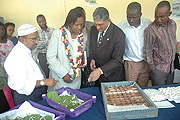I am writing in reference to an article that appeared in The New Times, on the 15th of Monday 15th June 2009 under the headline “Sericulture limited by funding – OTF research”.


I am writing in reference to an article that appeared in The New Times, on the 15th of Monday 15th June 2009 under the headline "Sericulture limited by funding – OTF research”.
This article according to me appeared to downplay government’s role in fast tracking the development of the silk cluster. As a member of the OTF Group I would like to dispel that perception and provide an accurate representation of the facts.
Government has been the key driver of the silk cluster in Rwanda and continues to invest in initiatives throughout the silk value chain aimed at enhancing production.
Silk has a significant potential in Rwanda and a strong basis for the sector’s development is already in place.
Currently almost 300 hectares of mulberry have already been planted with 646 hectare available for expansion.
Mulberry grows particularly well in Rwanda, with our fertile soils and favourable climate allowing for at least 8 silkworm rearings for cocoon production per year compared to only 2 in South Korea.
Furthermore, international experts at the Ministry of Agriculture (MINAGRI) and UTEXRWA suggest that Rwanda’s silk is comparable with Brazilian silk which is seen as the highest quality in the World.
I would also want to point out that government has put efforts aim ed at raising productivity and ensuring that farmers have access to the necessary inputs.
For example MINAGRI, RHODA and Horizon are currently partnering with rural cooperatives and farmers to finance the construction of additional rearing houses where farmers will provide local construction material such as ‘rukarakara’ blocks and provide labour, while the government provides cement and roofing materials.
Earlier in June, a silk cluster working group was launched with the main objective of bringing together all the stakeholders in the cluster to facilitate such partnerships across private and public sectors together with donors and farmers.
The aim of this working group is to assess progress and to collaboratively find solutions to issues affecting the development of a dynamic silk cluster.
The message that OTF Group was trying to convey at the cluster launch event, was that, while the Government is playing a leading role in the development of the silk cluster, there is a need for the private sector to play its part.
Silk can be a good cash crop for farmers with annual profits per hectare of up to RWF 1.4million from silk cocoon production. Hence farmers should not be waiting for Government handouts but need targeted support to help them to invest in their own success.
It is important to note, however, that the greatest impact from silk cocoon production lies in the value that can be gained from turning the cocoons into silk yarn, fabric and ultimately garments or other products.
This value can also be captured in rural areas, but requires further private sector investments, specifically in the development of hand reeling and hand looming capacity for the production of handmade silk products as well as in the long term investments in upgrading industrial production capabilities.
The next steps for the silk working group will be to develop a marketing strategy for Rwandan finished silk products, based on detailed market research, customer analysis and market positioning studies.
These efforts should facilitate the needed investments in value addition which will ensure that silk plays a prominent role in Rwanda’s export diversification and long-term economic transformation.
With all these efforts it is therefore wrong for one to think there is less that government is doing to facilitate the process of developing a silk cluster that will steer forward the development of the industry.
The writer is a senior analyst at the OTF Group in charge of the silk cluster


